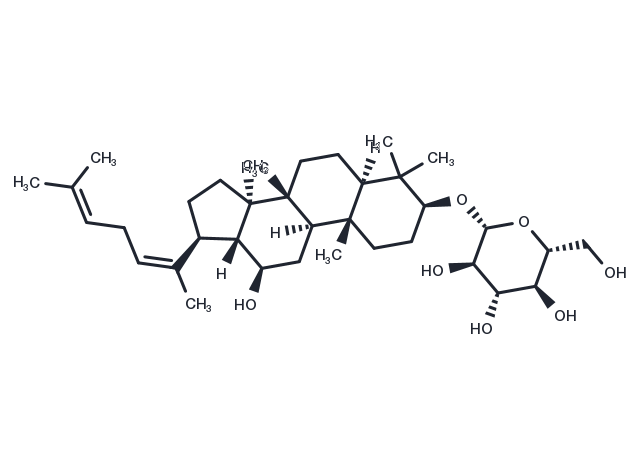store at low temperature
Powder: -20°C for 3 years | In solvent: -80°C for 1 year

Ginsenoside Rh3 is a natural product extracted from Ginseng C. A. Mey.Ginsenoside Rh3 has antifungal and antioxidant activities and induces Nrf2 activation in human retinal cells.

| Pack Size | Availability | Price/USD | Quantity |
|---|---|---|---|
| 5 mg | Inquiry | Inquiry |

| Description | Ginsenoside Rh3 is a natural product extracted from Ginseng C. A. Mey.Ginsenoside Rh3 has antifungal and antioxidant activities and induces Nrf2 activation in human retinal cells. |
| In vitro | Ginsenoside Rh3, at concentrations ranging from 0.01 to 10 μM, exhibits no cytotoxicity in tested models. In retinal pigment epithelium cells (RPEs), Ginsenoside Rh3 activates the Nrf2 pathway, as evidenced by dose-dependent increases in mRNA and protein levels of Nrf2-regulated genes, such as HO1, NQO1, and GCLC, following treatment. This enhancement in gene expression indicates a potentiation of cellular antioxidative mechanisms without altering Nrf2 mRNA levels, although Nrf2 protein levels significantly rise post-treatment with Ginsenoside Rh3 (3-10 μM). Additionally, the viability of SP 1-keratinocytes in response to Ginsenoside Rh3 has been evaluated using the EZ-Cytox assay, further delineating its safety and therapeutic potential. |
| In vivo | Ginsenoside Rh3 (5 mg/kg; intravitreal injection; 30 min pre-treatment) significantly attenuates light-induced decrease of both a- and b-wave amplitude. The electroretinography (ERG)'s a-wave decreases to 46.03±1.62% % of the control level after light exposure, which is back to 71.84±7.51% with Ginsenoside Rh3 administration. The b-wave is 40.19±3.34% of the control level by light exposure, and Rh3 intravitreal injection brings back to 80.01±2.37% of the control level.[1] |
| Cell Research | SP-1 keratinocytes are seeded in 96 well plates (2×10^4 cells/well). After 24 h, the media is replaced with media containing various concentrations of (A) SKRG, or (B) Ginsenoside Rh3 (0.01, 0.1, 1 and 10 μM). Control cells are treated with DMSO at a final concentration of 0.1%. After 24 h, the media containing the compounds or DMSO is replaced with media containing 10% EZ-Cytox. The cells are then incubated at 37°C for 1 h, and the absorbance is measured using a microplate reader at a wavelength of 450 nm. All assays are performed in triplicate [2]. |
| Animal Research | The BALB/c mice (male, 5-6 week old, 17-18 g weight) are used. The pupillary dilation is performed before exposure to 5000 lx of white fluorescent light. Thirty min before light exposure, Ginsenoside Rh3 (at 5 mg/kg body weight) is injected intravitreally to the right eye. ERG recording after light exposure is also reported early. The b-wave amplitude is measured from the trough of the a-wave to the peak of the b-wave, and the amplitude of the a-wave is measured from the initial baseline [1]. |
| Source |
| Molecular Weight | 604.86 |
| Formula | C36H60O7 |
| CAS No. | 105558-26-7 |
store at low temperature
Powder: -20°C for 3 years | In solvent: -80°C for 1 year
Ethanol: 25 mg/mL (41.33 mM)
DMSO: 3.02 mg/mL (5 mM), Sonification and heating are recommended.
You can also refer to dose conversion for different animals. More
bottom
Please see Inhibitor Handling Instructions for more frequently ask questions. Topics include: how to prepare stock solutions, how to store products, and cautions on cell-based assays & animal experiments, etc.
Ginsenoside Rh3 105558-26-7 Immunology/Inflammation Microbiology/Virology oxidation-reduction Antioxidant Antifungal Nrf2 Ginsenoside Rh-3 inhibitor inhibit
